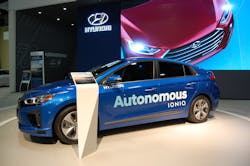Vehicle-to-vehicle (V2V) technology is being aimed for implementation starting in 2020, with the goal of increasing highway safety.
But Avinash Salelkar, head of manufacturing at information technology firm Syntel, argues unless such “short-range” communication networks are integrated into “active systems” such as automatic emergency braking (AEB), via the more “globalized” Internet of Things (IoT), those full safety “benefits” won’t be realized.
“Many new vehicles are already equipped with active systems that act in the event of an imminent collision. However, in order for tomorrow’s V2V technology to improve road safety, it is essential that it integrates with active systems that can steer away and brake,” he explained in a recent research note, “Without such active systems, V2V technologies will only be useful in the case of an inattentive driver.”
Salelkar added that V2V systems are expected to use the 5.9GHz safety spectrum, which was allocated by the Federal government to ensure that V2V and vehicle-to-infrastructure (V2I) communications run without interference.
Each vehicle would beam GPS coordinates, speed and direction data. Nearby vehicles would receive the data, analyze it with on-board computers, send safety alerts, and engage collision-avoidance systems, he explained.However, if IoT-based “connected car” technology was instead deployed to achieve V2V communication, there might be more benefits.
“The benefits of IoT-enabled cars include real-time monitoring of vehicle health, the ability to provide predictive maintenance reminders, and establishing a feedback loop where vehicle performance data is sent back to manufacturers to make future models more reliable,” said Salelkar. “At this point, it appears likely that the V2V and IoT approaches will work separately.”
Another “greater challenge” he foresees ahead is how the current vehicle population is addressed in terms of integration with V2V-equipped cars.
“In a scenario with a mix of transmitting and non-transmitting vehicles, the non-transmitting vehicles would be ‘invisible’ in certain respects to V2V-equipped vehicles,” Salelkar said.
About the Author
Fleet Owner Staff
Our Editorial Team
Kevin Jones, Editorial Director, Commercial Vehicle Group
Cristina Commendatore, Executive Editor
Scott Achelpohl, Managing Editor
Josh Fisher, Senior Editor
Catharine Conway, Digital Editor
Eric Van Egeren, Art Director

